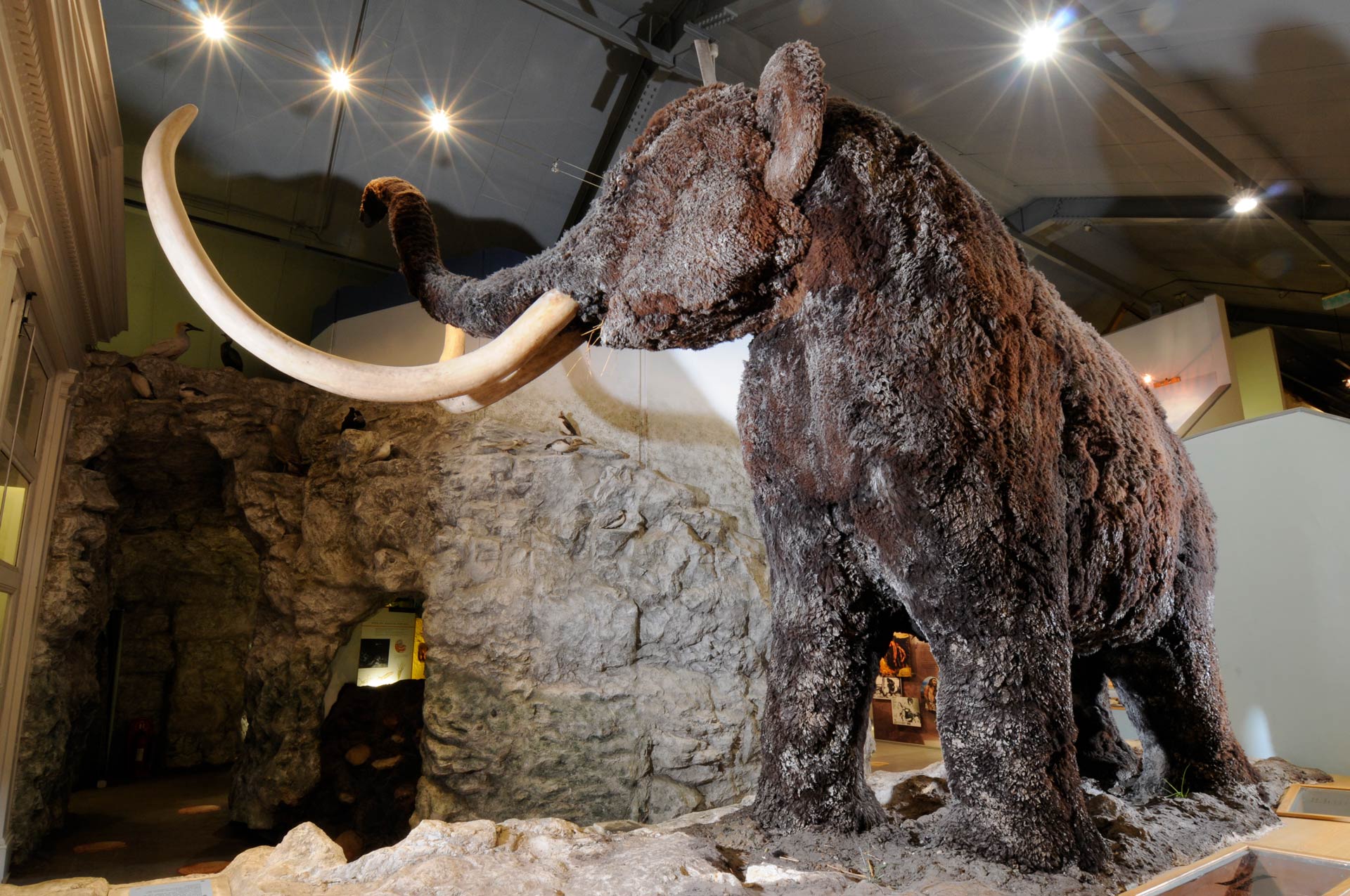Mammoths
Meet Mortimer, our life-sized reconstruction of a Woolly Mammoth. Mortimer is a firm favourite here at the museum, and it's not hard to see why!
These icons of the last Ice Age have been extinct now for thousands of years. But fossils, frozen bodies and ancient cave paintings help us piece together a picture of how the mammoth lived.
Come visit Mortimer, then explore our collection of mammoth teeth and fossil bones to discover the story of these magnificent beasts.

The Last Ice Age
The Woolly Mammoth lived in the last Ice Age, from around 250,000 years ago. Despite popular belief, they didn't live on glaciers. Such a barren environment wouldn't have enough food to support these massive animals. Woolly Mammoths actually lived in sub-arctic tundra regions.
Artefacts in our collection suggest that Mammoths lived in East Riding around 75,000 years ago, during the onset of a cold stage. During this period, summers could have reached highs of 10ºC. But in the winter months, temperatures would plunge to as low as -20ºC. The mammoths had several adaptations to help them survive in these harsh conditions...
Hair
Woolly Mammoths had an overcoat of thick, coarse, dark, long hair. On the underbelly, this hair could reach 1 m in length! Underneath was even more hair: a 2.5 cm thick undercoat of dense, fine, woollen, yellow-brown fur.
The Woolly Mammoths' skin was thick and grey, similar to that of an elephant. Special glands covered the skin, secreting fatty grease into the hair to give further protection against the cold. Beneath the mammoth's skin was a thick layer of blubber-like fat. In the more temperate summer climate, the mammoth would moult.
Tusks
Woolly Mammoths had huge curved tusks. These could reach 5 m in length, more than twice the length of a male African elephant. Mammoths used their curved tusks like a shovel to clear the snow and get to food buried beneath. Tusks were also used for self-defence and mating rituals.
Size
Woolly Mammoths were huge creatures, growing to about 330 cm or 11 ft – similar to modern Indian Elephants. They weighed as much as eight tonnes or over 8100 kg, which is the same weight as a London double-decker bus!
A fully grown Woolly Mammoth would have needed to consume over 100 kg of vegetation every day. Some researchers believe that mammoths dedicated 20 hours of their day to eating!
Mammoth's teeth were adapted to cope with grinding the staple food of their diet; harsh, tough, tundra vegetation. Like elephants, mammoths grew six sets of teeth during their lifetime. A set consisted of four teeth in total: two at the top and two on the bottom jaw.
Despite their scale, Woolly Mammoths had much smaller tails, trunks and ears than the modern elephant. These adaptations helped to prevent excessive heat loss. An African elephant's ears can measure 1.8 m in length. Mammoth ears were tiny in comparison and would have been just 30 cm long. Mammoth trunks had two finger-like projections, used to grasp the rough tundra shrubs they ate.
The end of a Mammoth era
In the last Ice Age, the Woolly Mammoth was a successful species. They roamed throughout the northern sub-arctic tundra regions, from Britain to Siberia; through Europe, Asia and North America.
Despite their once large number and numerous adaptations, they have since become extinct. It's likely that a combination of events brought about its end…
Over Hunting
Mammoths were extensively hunted by our ancestors. Their large size and relatively slow speed made them easy targets for the skilled nomadic hunters who preyed on them. Mammoth remains have been uncovered beside early hunting tools, and bones show evidence of butchery. Mammoth flesh provided food, while their huge skins supplied hunters with material for clothing. Their bones were also carved for tools, musical instruments, jewellery and combs. Evidence even suggests that huge Mammoth bones were used in the construction of huts.
Disease
Our ancestors and their domesticated animals carried fleas, ticks and lice. These critters could easily pass on deadly bacteria. There's a chance that when humans first came into contact with Woolly Mammoths, they may have passed on new diseases. Illnesses to which the mammoth had no immunity. From there, disease could pass through a herd killing many animals in a short amount of time.
Environmental change
12,000–10,000 years ago, the Ice Age began to thaw. As a result, the mammoth's sub-tundra habitat and food sources began to disappear. During this period, thousands of large mammals found themselves in an unfamiliar climate and became extinct. This includes many camels, horses, bears, sabre-toothed cats, the giant rat and the woolly rhino. Fossil records show that Woolly Mammoths disappeared from Britain and beyond in this period. However, in 1993, discoveries made on Wrangel Island off the coast of Siberia suggest that a dwarf variety, no taller than 2 m high, existed. These miniature mammoths clung to a final cold corner of the globe until as little as 4,000 years ago.
Back from the dead?
Whatever it was that caused the extinction of the Woolly Mammoths, they are no longer with us. Some scientists are keen to change this. They hope to revive the beast with DNA recovered in frozen mammoth remains. These scientists hope to breed a mammoth using the egg of its closest living relative, the Asian elephant. This could produce a creature that is 88% mammoth within 50 years... imagine that!

